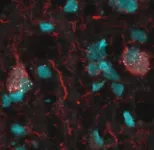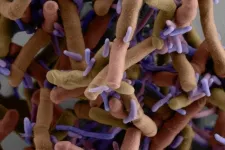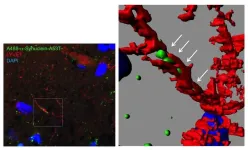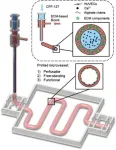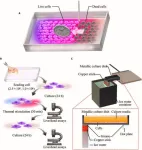(Press-News.org) WINSTON-SALEM, N.C. – Sept. 7, 2023 – Alzheimer’s disease is the most common cause of dementia that affects more than 6.5 million Americans, according to the Alzheimer’s Association. To find effective treatments and slow the progression of this debilitating disease, researchers have made much progress in developing new drugs that target beta-amyloid plaques, one of the hallmarks of Alzheimer’s disease.
Beta-amyloid plaques are accumulations of brain protein fragments, which can impact cognition. However, these recent drugs have only yielded modest results.
Now, scientists at Wake Forest University School of Medicine are reporting results from a Phase I trial in another area of promising research—cellular senescence.
The findings appear online today in Nature Medicine.
Senescent cells are old, sick cells that cannot properly repair themselves and don’t die off when they should. Instead, they function abnormally and release substances that kill surrounding healthy cells and cause inflammation. Over time, they continue to build up in tissues throughout the body contributing to the aging process, neurocognitive decline and cancer.
“In 2018, we found evidence of senescent cells in human Alzheimer's disease,” said Miranda Orr, Ph.D., associate professor of gerontology and geriatric medicine at Wake Forest University School of Medicine. “In mouse models, we also found that they contribute to brain cell loss, inflammation and memory impairment.”
Researchers repurposed a U.S. Food and Drug Administration-approved drug designed to clear cancer cells (dasatinib) in combination with a flavonoid, a plant-derived antioxidant (quercetin).
“Our previous research has shown that the combination of these two drugs target senescent cells and allow them to die,” Orr said. “We know that they cleared senescent brain cells in Alzheimer’s disease mouse models, and they had already been shown to be safe in patients with other ailments.”
For the current study, which was co-led by Mitzi Gonzales, Ph.D., of The University of Texas Health Science Center at San Antonio, the research team enrolled five participants aged 65 and older with symptoms of early-stage Alzheimer’s disease. Participants received oral dasatinib plus quercetin over two consecutive days, followed by two weeks of no drugs. The cycle repeated six times for a total of 12 weeks.
“Our primary goal was to determine whether the medicines penetrated the central nervous system,” Orr said. “We collected samples of patients’ cerebrospinal fluid (CSF) before the first dose of medicine was given and after the last dose of medicine was given.”
The research team also collected data on the safety and efficacy of the two drugs by monitoring side effects. They assessed biomarkers of senescence in CSF and blood, and also evaluated patients’ cognition and brain images before treatment and after they completed the 12-week study.
They found that both dasatinib and quercetin levels increased in the blood, and dasatinib was detected in the CSF in four subjects. Quercetin was not detected in the CSF of any participants.
“We also determined that the treatment was safe, feasible and well-tolerated,” Orr said. “There were no significant changes in brain function as determined by assessing memory and brain imaging to provide additional evidence that it is a safe therapy to evaluate further.”
Researchers also saw evidence to suggest that the combination therapy cleared amyloid from the brain and lowered inflammation in the blood.
“However, we shouldn’t over-interpret these results,” Orr said. “There was a small number of people enrolled, there was no placebo arm to compare results.”
Researchers also noted an increase in inflammation in CSF biomarkers. According to Orr, one possible explanation is a transient increase in inflammation when senescent cells are cleared. This increase could also be a marker of senescent cells dying or could potentially indicate inflammation associated with the treatment.
“We will need to monitor this closely in our next trial,” said Orr, whose cellular senescence research is currently featured in a special issue of National Geographic focused on aging.
“Dr. Orr’s research is a critical part of this pivotal moment in Alzheimer’s research as the focus shifts from amyloid and tau, the classic disease hallmarks, toward how the biology of aging underlies the disease,” said Howard Fillit, M.D., co-founder and chief science officer at the Alzheimer’s Drug Discovery Foundation (ADDF). “Aging is the leading risk factor for Alzheimer’s, and it is important that the field explores new approaches for developing therapeutics, like senolytics, that target biological aging. Alzheimer’s is a multifaceted disease, and similar to cancer, we will need multiple treatment options that can be combined and personalized to improve the outlook for millions of patients living with Alzheimer’s.”
Orr’s research team is in the process of a larger $3 million, Phase II clinical trial funded by the ADDF to test the effects of clearing senescent cells with the combination therapy.
“We can confidently move forward with a larger study population and placebo arm knowing that the treatment is safe,” Orr said. “We will also look forward to learning more about how the treatment may impact Alzheimer’s disease biomarkers.”
The study was supported by the Alzheimer’ Drug Discovery Foundation, GC-201908-2019443; the Coordinating Center for Claude D. Pepper Older Americans Independence Centers, U24AG059624; the Translational Geroscience Network, R33AG061456; the South Texas Alzheimer’s Disease Research Center, P30AG066546 and P30AG044271; San Antonio Claude D. Pepper Older Americans Independence Center, P30AG044271; National Institutes of Health/National Institute on Aging, R01AG077472, P30AG066546, T32AG021890, P30AG013319, U01AG22307, R01AG057896, 1RF1AG063507, R01AG068293, 1R01AG0665241A,1R01AG065301, P30 AG066546, U01AG046170, R01AG068030, R01AG080821, P30AG072947, P30 AG062677, U01 AG006786, U24 AG057437, U19 AG024904, R37AG13925, P01AG062413, R01AG066524, R01AG054076, R01AG033193, RF1AG059421, P30AG044271, P30AG013319, U54AG07594, R01AG069690, R01AG075684, R01AG068293; National Institute of Neurological Disorders and Stroke (R21NS125171), Cure Alzheimer’s Fund and Hevolution Foundation/American Federation of Aging Research; and the U.S. Department of Veterans Affairs, I01BX005717; JMR Barker Foundation, Bill Reed Endowment for Precision Medicine, the Kleberg/McGill Foundation, UT STARS award; National Center for Advancing Translational Sciences NRSA Training Core , TR002647; and the National Institute of Neurological Disorders and Stroke, R21NS125171.
END
Phase I clinical trial shows treatment designed to clear senescent cells in Alzheimer’s disease is safe
2023-09-07
ELSE PRESS RELEASES FROM THIS DATE:
Ravenous black hole consumes three Earths’-worth of star every time it passes
2023-09-07
A star like our own Sun in a nearby galaxy is gradually being eaten away by a small but ravenous black hole, losing the equivalent mass of three Earths every time it passes close.
The discovery by University of Leicester astronomers is reported today (7 September) in Nature Astronomy and provides a ‘missing link’ in our knowledge of black holes disrupting orbiting stars. It suggests a whole menagerie of stars in the process of being consumed that still lie undiscovered.
The team was supported by the UK Space Agency and the UK Science and technology Facilities Council (STFC).
The astronomers were alerted to ...
MIT engineers design more powerful RNA vaccines
2023-09-07
CAMBRIDGE, MA -- RNA vaccines against Covid-19 have proven effective at reducing the severity of disease. However, a team of researchers at MIT is working on making them even better. By tweaking the design of the vaccines, the researchers showed that they could generate Covid-19 RNA vaccines that produce a stronger immune response, at a lower dose, in mice.
Adjuvants are molecules commonly used to increase the immune response to vaccines, but they haven’t yet been used in RNA vaccines. In this study, the MIT researchers engineered both the nanoparticles used to deliver the Covid-19 antigen, and the antigen itself, to boost the immune response, ...
Genetic tools probe microbial dark matter
2023-09-07
Patescibacteria are a group of puzzling, tiny microbes whose manner of staying alive has been difficult to fathom. Scientists can cultivate only a few types, yet these bacteria are a diverse group found in many environments.
The few types of Patescibacteria that researchers can grow in the lab reside on the cell surfaces of another, larger host microbe. Patescibacteria in general lack the genes required to make many molecules necessary for life, such as the amino acids that make up proteins, the fatty acids that form membranes, and the nucleotides in DNA. This has led researchers ...
Revolutionizing lithium production on a string
2023-09-07
A vital component of the batteries at the heart of electric vehicles and grid energy storage, lithium is key to a clean energy future. But producing the silvery-white metal comes with significant environmental costs. Among them is the vast amount of land and time needed to extract lithium from briny water, with large operations running into the dozens of square miles and often requiring over a year to begin production.
Now, researchers at Princeton have developed an extraction technique that slashes the amount of land and time needed for lithium production. The researchers say their system ...
Genetic study of blood glucose levels calls for stratified treatment with GLP-1R agonists in type 2 diabetes, reveals the role of the intestine, and impact on lung function
2023-09-07
New research highlights that genetic background can affect individual responses to GLP-1R agonist drugs.
Researchers reveal for the first time that high blood sugar levels in type 2 diabetes can play a causal role in lung disorders.
The study sheds light on the role of the digestive system, including the small intestine, ileum, and colon, in controlling blood sugar levels.
This is the largest-ever study into the genetic basis of random "round-the-clock" blood sugar levels.
Groundbreaking research published today in Nature Genetics describes the largest-ever study into the genetics of random "round-the-clock" ...
Bursting air bubbles may play a key role in how glacier ice melts, Oregon State research suggests
2023-09-07
CORVALLIS, Ore. – Oregon State University research has uncovered a possible clue as to why glaciers that terminate at the sea are retreating at unprecedented rates: the bursting of tiny, pressurized bubbles in underwater ice.
Published today in Nature Geoscience, the study shows that glacier ice, characterized by pockets of pressurized air, melts much more quickly than the bubble-free sea ice or manufactured ice typically used to research melt rates at the ocean-ice interface of tidewater glaciers.
Tidewater glaciers are rapidly retreating, the authors say, resulting in ice mass loss in Greenland, the Antarctic Peninsula and other glacierized regions around the globe.
“We ...
A secret passage for mutant protein to invade the brain
2023-09-07
Researchers from Tokyo Medical and Dental University (TMDU) show that the protein involved in Parkinson’s disease, α-synuclein, can propagate through the lymphatic system of the brain before it aggregates
Tokyo, Japan – In many neurodegenerative disorders, abnormal proteins progressively aggregate and propagate in the brain. But what comes first, aggregation or propagation? Researchers from Japan share some new insights about the mechanism involved in Parkinson’s disease.
In a study published ...
The need to hunt small prey compelled prehistoric humans to produce appropriate hunting weapons and improve their cognitive abilities
2023-09-07
A new study from the Department of Archaeology at Tel Aviv University found that the extinction of large prey, upon which human nutrition had been based, compelled prehistoric humans to develop improved weapons for hunting small prey, thereby driving evolutionary adaptations. The study reviews the evolution of hunting weapons from wooden-tipped and stone-tipped spears, all the way to the sophisticated bow and arrow of a later era, correlating it with changes in prey size and human culture and physiology.
The researchers explain: "This study was designed to examine a broader unifying hypothesis, which we proposed in a previous paper published in ...
Bioprinting methods for fabricating in vitro tubular blood vessel models
2023-09-07
A review paper by scientists at the Chonnam National University summarized the recent research on bioprinting methods for fabricating bioengineered blood vessel models. The new review paper, published on Aug. 1 in the journal Cyborg and Bionic Systems, provided an overview on the 3D bioprinting methods for fabricating bioengineered blood vessel models and described possible advancements from tubular to vascular models.
“3D bioprinting technology provides a more precise and effective means for investigating biological processes and developing new treatments than traditional 2D cell cultures. Therefore, it is a crucial tool ...
Titanium culture vessel presenting temperature gradation for the thermotolerance estimation of cells
2023-09-07
Hyperthermia is a potentially non-invasive cancer treatment that capitalizes on the heat intolerance of cancer cells, which are more sensitive than normal cells. In order to induce effective hyperthermia, it is necessary to apply the appropriate temperature according to the cell type, i.e., to comprehensively study the thermal toxicity of the cells, which requires accurate regulation of the culture temperature. Researchers from Keio University in Japan have developed a cell culture system with temperature ...
